How to write effective B2B cold follow-up emails

Let’s dissect the key elements of perfecting follow-up email strategies in B2B outreach. Get to know your target audience, leverage effective communication tactics and nurture those client relationships.
Once you’ve harnessed the power of the B2B cold email, your next task must be nailing that all-important sales follow-up email strategy.
With over eight years of testing and experimenting, we’ve found a sequence of four to six emails is your best bet. Any more, and we promise you won’t see a pick-up in results. You might even see a decline in your reputation…
Stick with us; we’ll show you how to perfect that golden sequence.
So, let’s make some magic. Having analysed the results of 78 million emails, we have a pretty good understanding of the do’s and don’ts of the chase.
The power of the cold follow-up
A good prospecting campaign involves a sequence of emails sent just at the right time. Give the prospect some time away from your initial approach – but not too much. It’s a fine line not to let that communication trail run cold.
Did you know, 70% of salespeople stop reaching out after sending that first email? With years of data behind us, we know this isn’t a wise move. You could lose 76% of your total leads by not having a sequencing strategy.
The role of the follow-up email is to maintain contact and nurture a relationship with your prospects. Done well, your follow-up emails will keep your business top-of-mind and increase the number of leads coming from your campaigns.
Now that we understand why it’s essential to follow up, let’s dive into understanding your audience, sending at the right time, and much more!
Step 1: Understanding your audience
If you’re prospecting in the first place, you probably already understand that you need to have a good idea of your target audience. But how well you’ve got to know them will be abundantly evident during that cold follow-up sequence.
So, you need to be well-equipped with an idea of your Ideal Customer Profiles and Buyer Personas. On the top level, your ICP guides you on what businesses to target (fingers crossed you’re already doing this), and Buyer Persons will help craft the content that sells. Both are crucial to the success of your follow-up strategy.
Cold email copywriting and outreach are people-focused: you need to know who the buyer is and what they need. Doing this at scale is challenging. So, your audience research and segmentation is your first step towards personalisation. And this element of personalisation is what will make you stand out.
It helps you to address unique needs and how your product or service can help prospects.
Building your Ideal Customer Profiles
The sole purpose of your ICP is to provide a clear picture of the target market your product or service can help with. It comprises a list of qualities a prospective company must have to be in your total addressable market. It is a prerequisite for them to convert and buy from you. So, the development of your ICPs must come before those sales email follow-ups.
Define your ICP
First and foremost, it’s okay if you have more than one ICP – many brands do! Having several ICPs helps you capture the different segments that might benefit from your product or service (and why). These segments will have their own characteristics, challenges and goals.
The essential information you should collect includes:
| Company size | Number of employees, annual revenue. |
| Industry or sector | Specific industries the company operates in. |
| Geographic location | Where the company is based or operates. |
| Decision-maker characteristics | Job titles and roles of key decision-makers. |
| Pain points and challenges | Specific problems the company faces that you can solve. |
| Buying process | How they typically make purchasing decisions. |
| Budget | Typical budget range for relevant products/services. |
| Goals and objectives | Key business goals and objectives. |
The benefits of an ICP
These definitions will help you roll out marketing campaigns that resonate, leading to better engagement. And what will that lead to? Better sales! ????
This will aid you in identifying your target market and its segments and allow your sales teams to articulate the specific challenges your business tackles – ensuring that your offerings will resonate!
What does this look like in theory? Well, “large enterprises” is too large of a segment and, honestly, doesn’t provide enough detail. Instead, defining your ICP well should be more specific, for example, “healthcare providers with 500-1000 employees, using cloud-based patient management systems”.
This level of segmentation will go a long way in helping your sales and marketing teams create tailored and hyper-personalised messaging.
Understanding your Buyer Personas
Your Buyer Persona is a generalised representation of your ideal customer. Built around personal aspects and career history of the decision-makers within a business and their daily challenges.
On top of this, to develop your Buyer Persona, you need a detailed view of where those decision-makers seek out or consume information. It will help you to narrow down your targeting and offer valuable insight into what their buying process might look like.
Building your Buyer Persona
Having detailed Buyer Personas comes from detailed data. So, get stuck into those qualitative and quantitative details!
You’re likely to have more than one Buyer Persona, too! To gather enough detail on what they might look like, you can pull from your CRM (right at your fingertips!), prospecting data, web analytics (eek, here’s a GA4 breakdown for those that have been avoiding it), social media and interviews with pre-existing customers. If you already have a great relationship, why not make the most of it?
Some key characteristics you’re looking for when mapping out the data should include:
| Job title and role | Specific job titles and roles within the target company. |
| Professional background | Key experience, skills, and career highlights. |
| Day-to-day responsibilities | Core tasks and responsibilities in their role. |
| Challenges and pain points | Specific work-related problems and challenges they face. |
| Goals and objectives | Professional goals and objectives they aim to achieve. |
| Decision-making influence | Their role and influence in the buying process. |
| Preferred communication channels | How and where they prefer to receive information (e.g., email, LinkedIn). |
| Content preferences | Types of content (e.g., whitepapers, case studies) that resonate with them. |
| Budget authority | Their role in budget decisions and typical budget constraints. |
The benefits of Buyer Personas
Did you know? 72% of B2B buyers expect personalised engagement that is tailored to their needs – including those cold emails and the all-important cold follow-ups!
Understanding your target audience in greater detail will help you to create that expected level of tailored and personalised messaging. So, you just know that your recipients will love it. So much so that utilising buyer personas has been shown to double email open rates and increase click-through rates by 500%.
And we’re not done convincing you just yet! When targeting cold leads, content built around those personas increases engagement by up to six times. Now, that’s what we like to see.
So, without a shadow of a doubt, both ICPs and Buyer Personas lead to elevated results for outreach. With more personalisation comes increased engagement, and with that comes shorter sales cycles. Oh, yes.
Want the full details on reaching the right business and crafting the perfect content to boot? You know what to do. ????

Ideal customer profiles and buyer personas
Find out how to utilise them together for better sales and marketing output!
Read moreStep 2: Timing is everything
Follow-up emails are a delicate topic – there’s a fine line between being persistent and spammy. It sometimes all comes down to the art of timing.
From that first email, there should be around a two to three-week sequence that follows (if you’re using email-only, that is… have you checked out the multi-channel approach?).
It goes a little like this:
1 – Your initial email goes out
2 – A first reminder goes out. Send it three to six days after the previous one (but not five days, to avoid it landing on the same day of the week)
3 – A more persuasive email. It adds a little more value, perhaps following up with a free resource. Alternatively, you can ask for a referral to a more relevant party. Send this another three to six days later.
4 – Here comes the break-up. Be gentle, be kind. You’re not here to pester, but you want to make it clear this is the end of your outreach. You guessed it, leave it another three to six days before sending.
But remember, what this looks like can differ depending on your data and audience. Find out what works in your industry and be open to changing over time.
A helpful starting point to dive deeper into those ‘best times’ is to check out our State of Prospecting Report 2025. It takes a detailed look at the best days and times to send outreach emails based on levels of engagement. However, this does come with a word of warning!
Don’t be tempted to execute bulk sends at one time. It can hurt your domain reputation and harm your deliverability. No one wants that.
Before we delve deep into the art of the email follow-up, we beg of you not to be wary of the ol’ out-of-office. Everyone needs a break sometimes. However, don’t let this leave a dent in your sequence.
That quick off-the-mark OOO email lets you know the exact date your prospect returns… and when to follow up! Mark it in your calendar, and reach them when they’ll be working through their emails. Pro tip: give them a couple of days to catch up on what they’ve missed first. Your prospecting results shouldn’t be negatively impacted.
Step 3: Crafting the perfect follow-up sales email
There are four key elements to your follow-up emails. This includes the subject line, opening line, main body content and calls to action.
Let’s get cracking with the inner workings of what a great email looks like, and then we’ll focus on each follow-up. Grasp the basics and weave them into your outreach.
Subject lines
Email subject lines are an excellent outlet for a spot of A/B testing. Have a play around. See what works and what to avoid. It’s an easy form of testing to implement, and you’ll see those results very early on.
Contrary to popular opinion, judging a book by its cover is standard in this day and age. Assuming your email has made it through the sea of outreach that we all receive daily, the first visible line of text needs to create enough intrigue to be opened.
Here at Sopro, email was our primary form of outreach when we first began. So, we have a mountain of data that looks at different subject line types, length, personalisation, and words and phrases. But let’s just stick to the basics for now.
Word count
There’s no big secret here. It won’t hit the mark if your subject line is too short. But it will get cut off and won’t be engaging if it’s too long. Results can suffer either way.
The sweet spot? Four to seven words. Make a significant impact in just a few words.
Subject line categories
You guessed it! Personalisation is the king of email outreach and is well-placed in your subject lines.
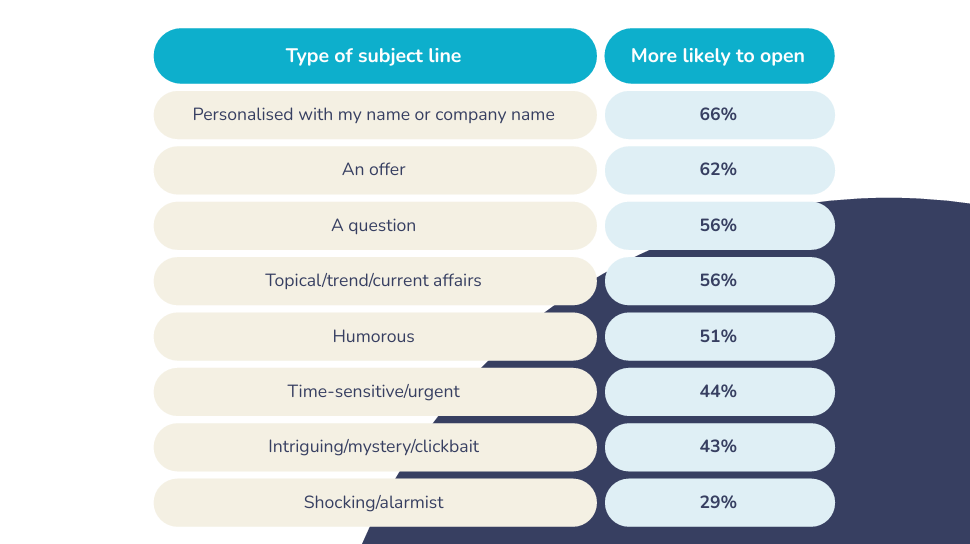
As you can see, approaching outreach by name significantly impacts open rate – it gives the impression that you either know them already or have done your research. Both bode well.
Following that, offers do well – we do love a little treat!
It could also be prudent to incorporate topical industry trends or current affairs. Perhaps not the weather, though. There’s no drier conversation to be had. Unless, of course, it starts snowing in July.
Dig deeper: time-related personalisation
There’s personalisation, and then there’s time-related personalisation – and data from our latest report indicates that this is king.
If you aren’t already adding at least a first name to your outreach, then we hate to tell you… you’re a little behind the game. ????
Adding an extra layer concerning the day, date, or time can add a layer of urgency and intrigue.
Example: Daniela, don’t miss out! Friday freebie inside.
Opening line
Once you’ve nailed the subject line, it’s time to focus on that next big step. The opening line of your email! *Insert screaming here*
Just kidding, it’s not that scary.
You can take a few avenues here to embody personalisation, a tailored message, and present your email beyond a sales pitch.
Here are a few great ideas:
- Using questions
Did you know [interesting statistic]?
Are you experiencing [pain point]?
- Reference a trigger event (because you’re tracking those)
Interested in our blog about [blog name]?
I saw you download our resource on [resource name]…
- Take special notice of their recent work
I saw your post on [subject] and thought it was an interesting take…
I’ve been in the industry a while now, and your [thoughts] on [subject] have caught my eye.
Congratulations on your recent [promotion]/[industry award]!
- Leverage things in common
I noticed we have a few shared connections on LinkedIn. How long have you been with [Company name]?
I saw you share some industry updates on [subject], and I’ve been interested in this for a while now…
- Add some value
We’ve recently produced the report [Report name], and I thought you’d be particularly interested in the results of [subject]…
We’ve worked with companies in [relevant industry] and have a helpful tool for [pain point]. Are you interested in a free trial?
The main body
The subject line is nailed. The first line is decided. Now, it’s time to give a little love to the main body of your cold follow-up email. Just because you’ve maintained the focus of your recipient up until now, it’s not the time to relax.
First up, message length. And it shouldn’t be surprising that no one will read an essay. Not even if it’s a short history of their own career experience. We love a sales rep that does their research, but hey, we’ve lived it.
We’ll say it once. We’ll say it again. Keep it brief.
151-200 words are around the number that you should be working with. In this space, you should be able to persuade and add value to your messaging.
So, what themes should your emails leverage? Our data wizards poured through millions of emails to identify what kind of messaging works and what doesn’t. Let’s take a closer look.
Emails that centre around assurance, cite prior contact, show action, add a nod to collaboration and a little flair of social proof all do pretty well regarding lead rates.
On the other hand, content that tries to provide solutions before discussion, is solely results-focused, and uses a lot of buzzwords or jargon has been shown to have a negative impact on engagement and overall lead rates.
This doesn’t just apply to your initial outreach. No one likes getting tricked. So keep your optimised messaging throughout every follow-up email. Consistency is key.
Want to dig a little deeper? Check out our latest report ⤵️
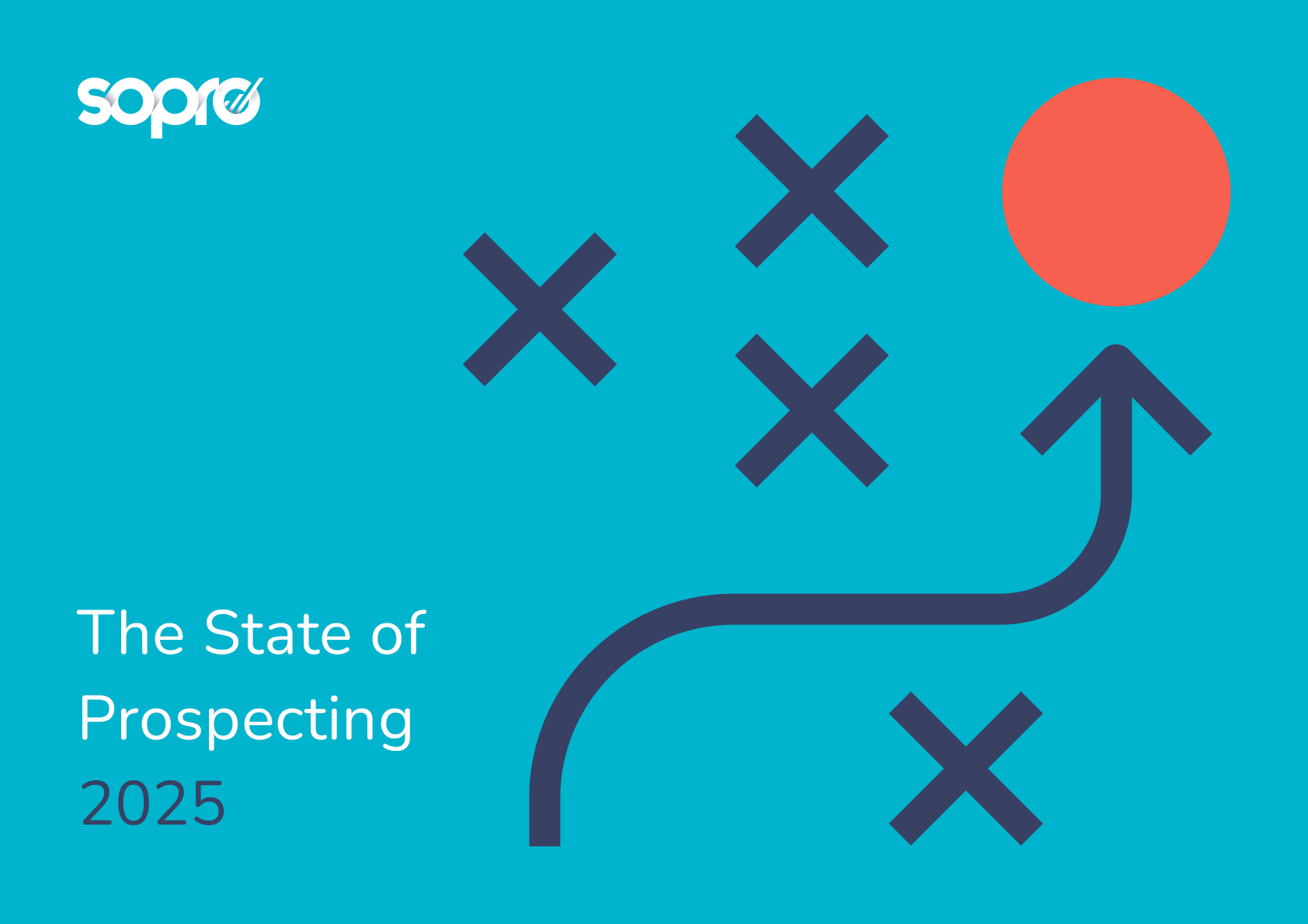
The State of Prospecting 2025
An in-depth look at the tactics and trends shaping successful B2B prospecting in 2025.
Download your copyCalls to action
Your calls to action must be clear and easily actionable to get to the next step with a prospect. Secondly, elements to focus on include being positive, non-intrusive, and relatable to the recipient’s needs.
Where you place your CTA can also have an impact. So, leverage that A/B testing. Will it detract from the main copy if it’s at the start? If it comes at the end, will the prospect have read all the way through? Have a play around and see what works for you.
Once you’ve put your email together, there’s only one thing left – the sign-off. Our guide explores how to end sales emails.
Different types of messages for the various stages of B2B email follow-ups
It might be obvious, but let’s make it super clear. From the initial email to every sales follow-up email that follows, the content will differ every time.
If you’ve read our thorough guide on mastering the B2B cold email, you have probably already finessed that original email. So, let’s focus on those stand-out B2B email follow-ups.
Chaser one: The nudge
- Follow up by forwarding the initial email
- They might have missed or forgotten about your email
- Include a simple, polite follow-up message to remind them
Chase two: The referral/add benefit
- Follow up by forwarding the previous email chain
- Reaffirm why they should want to speak with you
- Focus on helping, not selling. Add in a valuable resource if fitting.
- Suggest that it might be better for them to put you in contact with someone who may be better to speak to
Chaser three: The break-up
- The prospect may have lost interest entirely. You don’t want to hassle them
- They may assume if they ignore this message, you’ll keep emailing
- Let them know you’d love to speak with them
- But don’t wish to become a pest – this is the last email you’ll send
- If the Prospect wants to engage, they will after this email
Personalisation strategies to take note of
Throughout this blog, we’ve constantly referenced the power of personalisation. So, let’s dig a little deeper into that. Incorporating different layers of personalisation into your email outreach can benefit the response rate.
B2B emails have an average open rate of 15%, so curating customised content relevant to each potential customer is essential. Recipients should feel like they’re talking to someone who wants to better understand their needs and pain points instead of just another sales pitch.
Here are some top tips to help you resonate with your audience and hopefully see an increase in that reply rate:
- Cut down on the marketing speak. Your initial and follow-up emails should have a human touch and feel like a 1-1 conversation.
- Don’t stuff your email with personalisation fields. We get it. You know their name and where they work. Three fields of personalisation are plenty.
- Any additional information that shows you’ve done your research and is relevant to what you’re trying to convey is always a good move.
- Share success stories that resonate. Social proof will make you look good, instil trust and add authority. This is an excellent part of the sales process to take advantage of.
- No hard sells here, please. Add value, be patient and include a clear call to action to get your prospect onto a call.
The tech is available – use it!
Undoubtedly, integrating technology can improve the tracking and personalisation of cold follow-up emails. And let’s face it, plenty of companies are all making the most of streamlining their workflow – 91% of companies are now using a CRM!
A CRM is the centrepiece of B2B lead generation and prospecting. Find contact details, social tools and those all-important sales dashboards. By using a CRM, you can easily segment your audience based on behaviour and recorded preferences. This allows you to tailor your follow-ups easily.
Secondly, adding email automation tools streamlines your sales team’s workflow and leaves them to work on nurturing warm leads and closing sales! Pre-defined actions can trigger timely follow-ups, profoundly affecting engagement and higher conversion rates.
Step 4: Measuring success
What’s all this for if you’re not tracking the results?
You can constantly optimise content by measuring the success of your initial and follow-up sales emails. After all, we should always be striving to do better by our recipients!
So, what are those key metrics to measure in your email campaigns?
- Click-through rate
Your CTR is one of the most important metrics to track. It provides insight into how many people actively engage with your content by clicking a link. This highlights the percentage of people interested in learning more about your brand or offering.
- Open rate
Simple. This tracks how many recipients open your email. This key metric will help you identify if those subject lines are hitting the mark – perfect grounds for A/B testing.
- Conversion rate
Your conversion rates will help you monitor those who have followed the call to action you likely have in your email content. If you have a desired action like booking a call, filling out a form or downloading a free resource, this is the metric to look out for.
- Bounce rate
This concerns your deliverability and is one you want to look out for. And there are two types!
A soft bounce involves emails that were never delivered because of a problem on the recipient’s end, such as a full inbox.
A hard bounce is because of an invalid or closed email address. Internet service providers look out for hard bounces, which can affect your sender reputation. Be in the know with the latest on deliverability.
- The growth of your lists
Natural decay is likely for most email lists. So, running campaigns that will help with subscriber growth is essential – and be sure to track your progress!
- ROI
A standard metric that pretty much all teams will already be aware of – tracking your campaign spend vs total revenue. It’s there simply to remind you (and probably your boss!) how well this channel drives those results. Spoiler alert: it’s always worth the investment.
- Unsubscribes
This helps you keep an eye on the growth rate of your lists. It also gives you an indication of the success of your content. If you get a lot of unsubscribes after sending one particular email, the content may be off-putting.
By assessing data from open rates, click-through rates, and even responses, you can refine content, timing, and segmentation for more effective outreach, ultimately enhancing engagement and conversion rates.
Cold email follow-up templates!
So, let’s go from the top. A little refresher.
You’ve got an idea of how and why you must understand your target audience deeply. You’ve picked up the basics on timing and how your cold email follow-ups need to be persuasive, not pushy. We’ve run through the nitty-gritty details of subject lines to calls to action. And we’ve even touched on those all-important metrics to track.
You didn’t think we’d leave you without any examples, did you? Of course not!
To get you started, we’ve included some typical sales email templates, but we encourage you to to adapt and amend them. Every business and audience is different, but these should help you imagine what your follow-up sales emails could look like.
Email template: follow-up after a demo
To build rapport, it’s always great to check in after every face-to-face meeting to thank prospects for their time.
This is just to add value to what you’ve probably already discussed, providing information to other decision-makers and being on hand to negate any barriers there might be in the future.
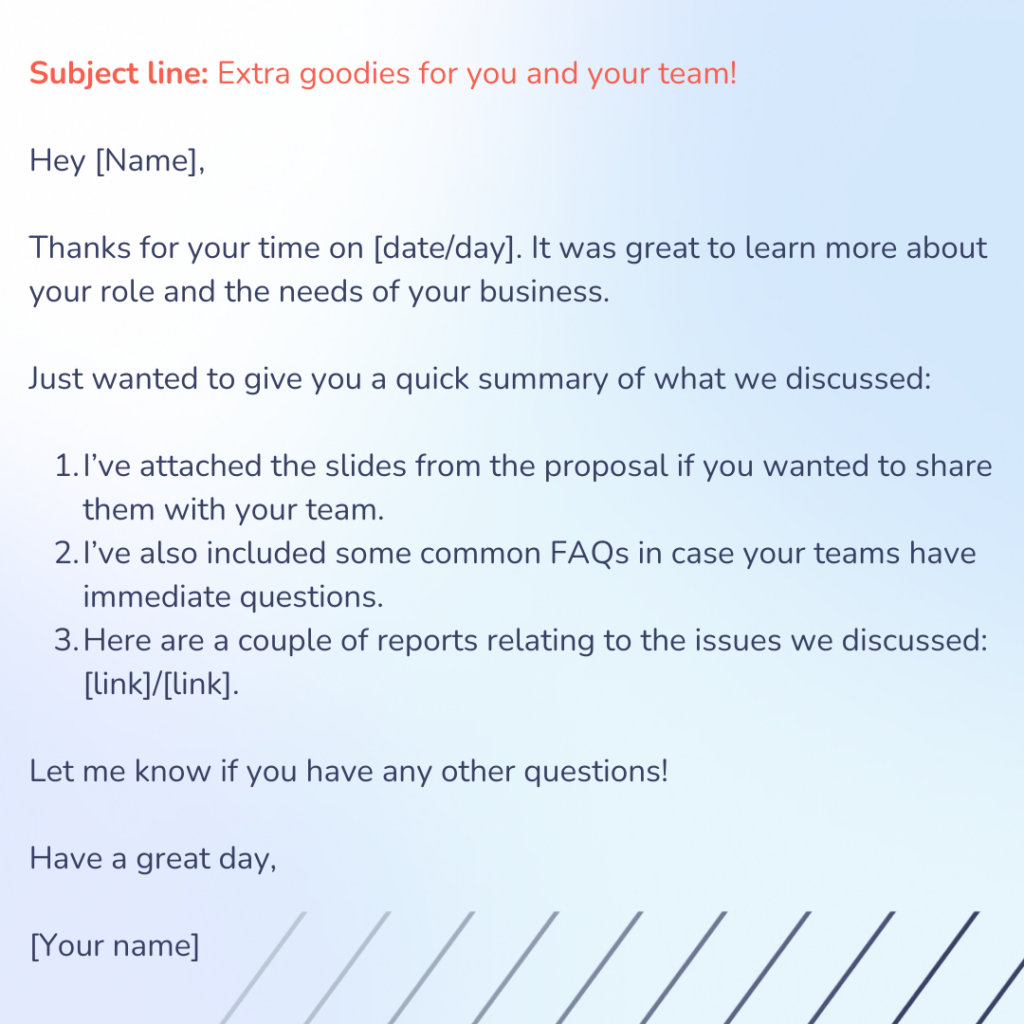
Example template: meeting follow-up
Again, thanking them for their time is a great way to start any follow-up interaction. However, this time, the email pays attention to the pain points they’re experiencing – you’re showing empathy! Not only that, but instead of offering to fix the problem immediately, you’ve offered a free resource. It highlights your expertise.
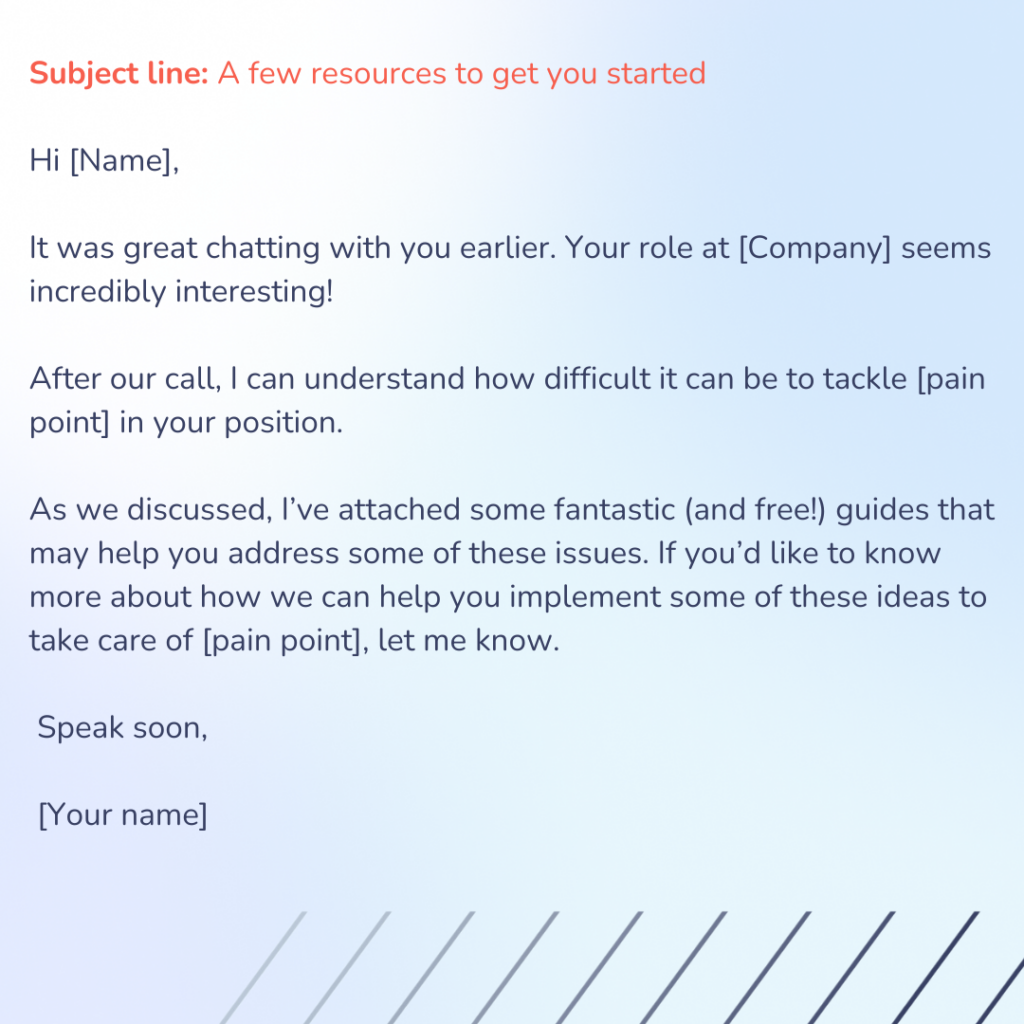
Example template: intent trigger follow-up
This is adaptable to any action the recipient might have taken that isn’t replying to your initial email!
It shows that you’re playing close attention to how prospective customers access your information. You can strengthen a possible relationship by suggesting even more!
This acts as a nice nudge that isn’t pushing them to respond.
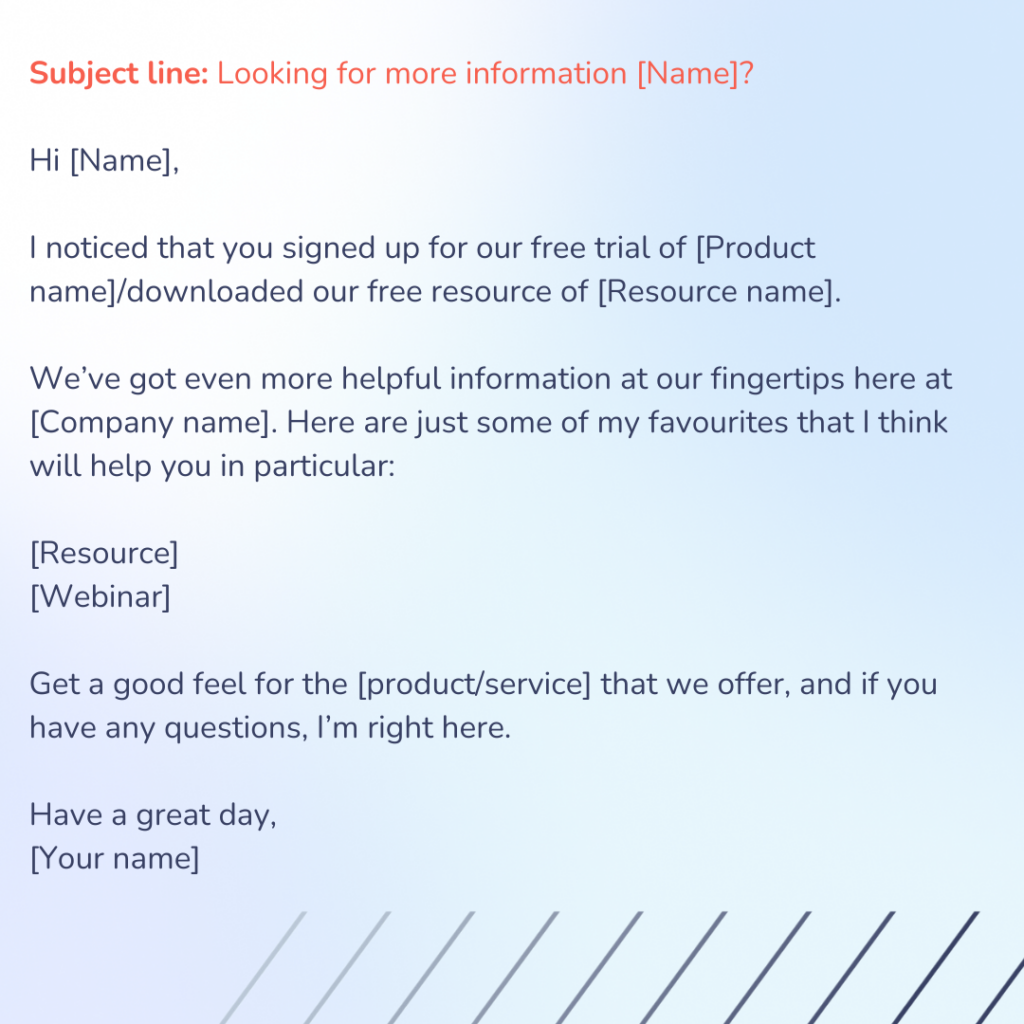
Example template: nudge with value
There’s nothing like some self-deprecating humour to kick things off. It highlights that the salesperson knows sales emails can sometimes be a bit much. But instead of a generic follow-up, it’s a way of adding value to the interaction with a free resource and highlighting how it can help with their particular pain point.

Example template: commonality follow-up
In this case, the commonality was attending the same event! Also, if you had a conversation, that shows off those active listening skills, – making them feel heard and valued.
This cold follow-up email exemplifies how using language that denotes prior contact, empathy, and a personal touch can always work.
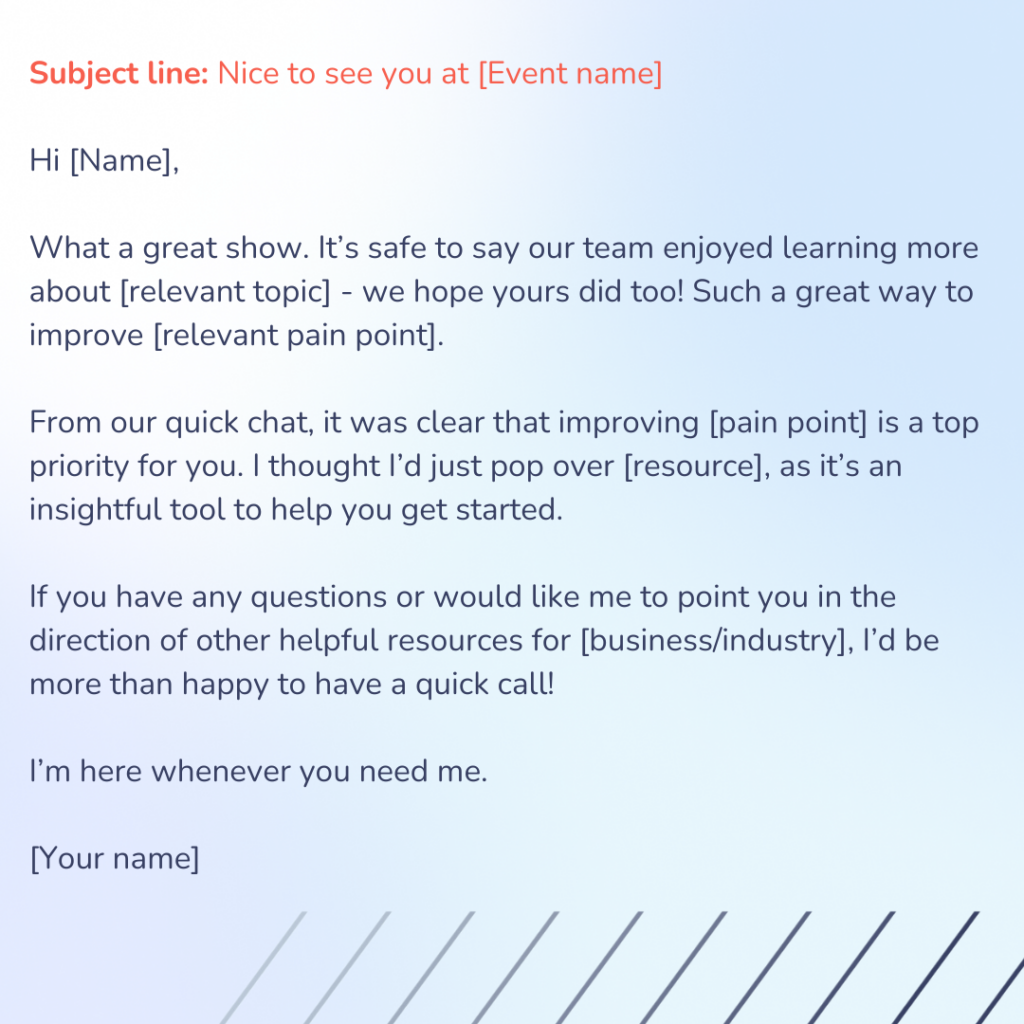
Bringing it all together
Mastering the B2B cold email is one step, but the next crucial step is bringing finesse to those chaser emails. Don’t give up – you can’t underestimate how much of an impact those cold email follow-ups can have on driving engagement and conversions.
As always, the first step to nailing those follow-ups is understanding your target audience. Get to know your ICP, become besties with those Buyer Personas, and you’re on your way to personalised outreach that resonates.
But there are so many things you can do beyond that! Get a handle on timing and the essence of a well-crafted sequence. Leverage the tech to optimise your sales team efforts. Measure your campaign metrics to refine strategies continually. And be sure to follow those best practice guidelines!
And soon, you’ll be on your way to nurturing relationships and driving sales.
Trust us, we’re the outreach experts, and we started as an email marketing agency. Your B2B follow-up game is poised for success with these insights and actionable templates. Wanting more? Get the inside track and some invaluable tips in our email marketing for lead generation strategies guide.
For more insight, check out our blog. Here you’ll find helpful guides to take your email marketing strategy to the next level, including:







Share